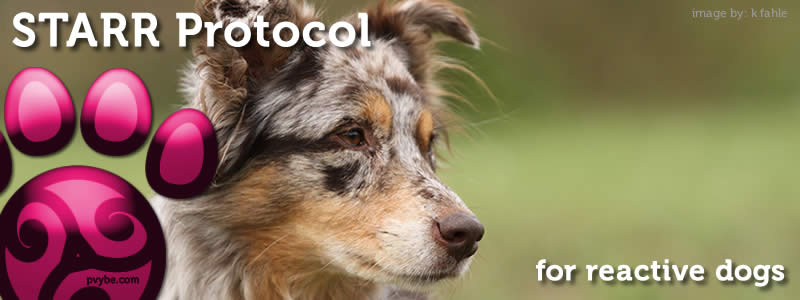
The Pawsitive Vybe STARR Protocol
STARR Protocol for Reactive Dogs

Working with reactive or fearful dogs is a specialty of Pawsitive Vybe. The key to dealing with these troubled dogs is allowing the dog to make decisions – simple decisions – that will help to center and ground them and to enable them to deal with environmental distractions on their own terms.
The Pawsitive Vybe STARR Protocol is an elegant system for handling reactive and/or reactive dogs.
Skinner Rocks but Pavlov Rules
The realm of rational decisions (operant behavior) are dictated by the classically conditioned state.
The woman who stands on the chair in the kitchen shrieking, broom in hand, in the presence of a mouse, is not making a rational decision. She canʼt. Sheʼs over threshold. Sheʼs making a silly decision, a decision that is at the mercy of her classically conditioned state due to seeing a mouse. The rational decision would be to take the broom and sweep the mouse out of the room. Spiderʼs? Get a paper towel and squish the spider. Duh…
Until the woman is under threshold in the presence of the mouse or spider, there will be irrational and crazy reactions due to the classically conditioned state that the trigger stimulus creates.
What you want to do with your reactive or fearful dog is foster an alternative classically conditioned state then work on the operant end. You bring the dog under threshold, and then go to work and keep him there.
Set the Tone
Setting the tone is about laying a proper classically conditioned state for work as you shift from a stable environment to an unstable one.
You want to reframe the dog’s understanding of the situation from a high energy or nervous emotional state with the expectation of play, aggression or fear, to an emotional state of calm with the expectation of work.
Whether it’s getting out of the Car, a Crate, or a Door to outside, any time you are getting ready to make a situational change, you want to set the tone and get the dog prepared to work with you before taking the dog into the new situation that may scare or excite the dog.
There It is!

Normally when the dog sees their trigger: a strange dog, a lone stranger, dogs playing, or whatever, a descending spiral of behavior starts. It goes something like this:
- Dog takes notice of the stimulus: There it is!
- The ears perk up: Iʼm interested!
- Heart races and body tenses: Iʼm aroused.
- Dog Explodes: Iʼm gone! (or stop holding me back!)
Marking the exact moment the dog takes notice of the trigger stimulus,There It Is!, short circuits this descending spiral of behavior by changing the progression right from square one.
Classical
At stage 1, the exact moment that the dog looks at the stimulus, mark and reinforce (preferably with food) directly in front of the handler forcing the dog to look away from their trigger to eat her cookie.
We believe this game is unique because it is the only game we can think of that is, at once, classical and operant conditioning.
Food is paired with the appearance of the trigger stimulus, reframing the classically conditioned state from trigger=heightened emotional state to trigger=food.
Operant
Then on the operant end, the act of looking at the stimulus leads to food reinforcement – behavior affects consequence.
The act of looking at the trigger stimulus becomes reinforcing in and of itself. Which leaves the reactive dog enjoying the act of looking at the trigger stimulus to get cookies on the handler and leaves the fearful dog enjoying the action of facing their fear. The classically conditioned state is addressed and the There It Is! behavior gives the dog a default behavior, a goto behavior, that allows them to perpetuate that classically conditioned state.
For both dog and handler the trigger stimulus becomes a tool for reinforcement instead of the object of the dogʼs drive or fear.
Attention
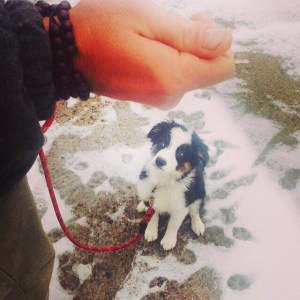
“Unsolicited eye contact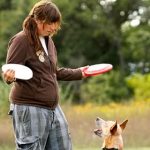 Unsolicited eye contact or Attention is a great way to hook up with a dog. If you have something the dog wants he should give eye contact in order to get access to... More, Attention as it’s called here at Pawsitive Vybe, is at the very root of our foundation and our philosophy.
Unsolicited eye contact or Attention is a great way to hook up with a dog. If you have something the dog wants he should give eye contact in order to get access to... More, Attention as it’s called here at Pawsitive Vybe, is at the very root of our foundation and our philosophy.
If you have to fight for a dog’s attention you are already behind the 8-ball, especially so with reactivity, aggression, or fear. Pawsitive Vybe dogs give the handler unsolicited eye contact any time there is something of value or when the situation is boring. Given a strong foundation of Attention, dogs will look to their handler’s very frequently.
This handler focus has been a foundation of positive dog training and reactive dog management for quite some time, but it’s very hard to continuously keep a dog’s focus on the handler in the presence of awesome things (reactivity) or a fear trigger. Also, if we are totally successful in holding the dog’s attention, then at some point in time, the trigger stimulus can unexpectedly pop into her vision or bump into her space at a distance that is overwhelming.
If the trigger stimulus is unexpectedly sprung on a dog frequently when doing reactive dog work, the dog starts to distrust the continuous handler focus. And if it happens enough, anxiety or fear may become classically conditioned and triggered with the simple act of Attention with or without the trigger stimulus present.
In our version of reactive dog management, we ping pong between There It Is! (no cue) and Attention. We capture these behaviors and add value to each one to achieve a balance of environmental awareness and handler focus.
Too much scanning of the horizon, and we add some Attention. Too much Attention and we add some There It Is!.
Release

The Release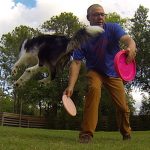 Release has many meanings in disc. Throws and throw variations can be referred to as releases. Sometimes you talk about the dog releasing something, the toy, or the environment, as in to stop... More is an important aspect of reactive dog management.
Release has many meanings in disc. Throws and throw variations can be referred to as releases. Sometimes you talk about the dog releasing something, the toy, or the environment, as in to stop... More is an important aspect of reactive dog management.
The Release is the moment that the dog releases the trigger stimulus after noticing and becoming engaged with it. Usually this release happens towards the handler.
Ideally, you only have the opportunity to work on the Release after the dog has had some success with There It Is! and Attention in the presence of the trigger stimulus. But nobody is perfect, and the Release is often worked when the handler misses There It Is! or as recovery from a reactive response.
The Release is the hardest part of many behaviors like Leave It, Recall, and especially recovery from fear and reactivity. It needs to be reinforced — a ton. It should not be the initial criteria, as it is challenging and might not happen at all of the dog winds goes over threshold, but after the dog is stable the Release can be used for proofing the dog in stable environments and situations.
Retreat
If at any time the situation becomes untenable for the dog, Retreat. Run Away! “Weʼre Outta Here!” Turn and move away from the situation regardless of what the dog is doing. Don’t wait! Just move.
When the dog releases the trigger stimulus, mark the Release and reinforce in Heel position. Continue to move away and reinforce the dog until the distance is great enough that the dog will stay under threshold. Take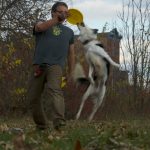 A Take is a cued Bite that replicates the placement and timing of a throw. Usually used with overs, vaults, and flips, the Take is a powerful teaching tool for creating habitual leaping... More a deep breath and go back to work with There It Is!
A Take is a cued Bite that replicates the placement and timing of a throw. Usually used with overs, vaults, and flips, the Take is a powerful teaching tool for creating habitual leaping... More a deep breath and go back to work with There It Is!
Ideally you never have to Retreat, but nobody’s perfect and life is full of surprises. It is important to do a good job of reading, working, and managing situations so that the dog remains under threshold. Each time a Retreat is forced on the handler, it is not just a retreat in that particular session or situation, you and your dog will be taking steps back in terms of your training in general.
What’s Next?
Once a reactive or fearful dog is stable and comfy, be prepared to shift gears and change tactics a bit to help the dog exist in the situation on her own. We’ve got a protocol for that too. It’s called DOC and will be outlined here on the blog in the near future.
In the meantime we’ll be fielding questions and discussing the STARR protocol in the comments below. Don’t be shy…




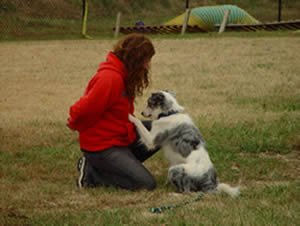

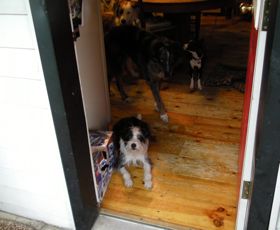
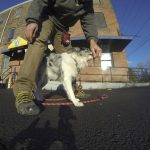
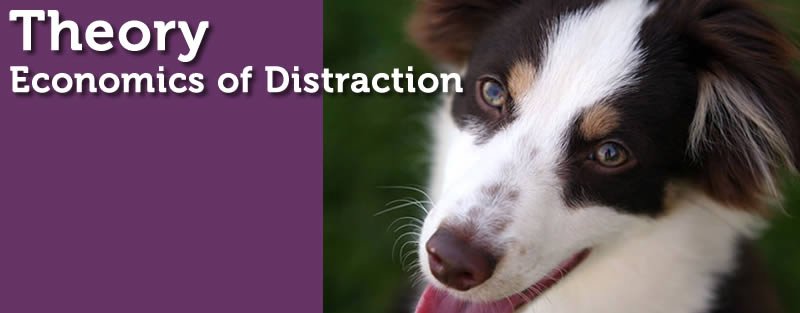
Isn’t this Leslie McDevitt’s Look At That? Not that I don’t think it is well-explained and useful to people but I do not see any essential differences.
It is very similar to Leslie’s work.
There It Is! most definitely based on Leslie’s Look at That (LAT), but LAT has been taught rather poorly IMO (and not by Leslie, BTW), and many handlers wind up reinforcing a heavy stare.
Also, this is an entire protocol with a simple acronym that is easy to remember and simple to verbalize, something that Control Unleashed is lacking.
There are many flavor differences that I am unable to articulate in a 1200 word blog post.
For instance we never cue the dog to look at that. There It Is! is a passive, captured exercise and uses passive language to reinforce that.
Setting the Tone is a major, focal component vs something that is taken for granted.
The Release is entirely different from There It Is! (LAT), a distinction that is desperately needed in common understanding of Control Unleashed.
Otherwise it’s pretty much the same stuff.
I believe that Control Unleashed is an outstanding protocol and have borrowed from it liberally, but again, it’s lacking continuity and organization and has taken a serious hit from instructors who think they know what they’re doing because they’ve read the book.
Peace~
Here’s my situation with “There It Is!”… I have one dog reacting aggresively toward another dog (also mine.) I can’t use food to distract the aggressor because that only piques the interest of the other dog and she comes closer….which is NOT what needs to happen at that moment. Any ideas on how to refocus attention away from a stressor (which happens to live in the same house 24/7) without food?
Control the Environment
Any time you are working on problems like these maintaining control over the situation is an absolute must – the situation must be structured for success.
You could have Steve work Irish on leash, you could tether her or put her in a downstay (if it’s solid). And you might want to leash Whiskey. The key is to maintain control over both dogs any time you are working this with food.
Create a Secondary Reinforcer
You could also add value to tactile reinforcement (petting) with the reactive dog by pairing petting with food in sessions designed specifically for increasing the value of petting and rely on that secondary reinforcement to reinforce the reactive dog for proper behavior. You could do the same with praise. These will both need to be tuned up from time to time, as they will lose their luster over time without the effect of being paired with something awesome.
Reactivity or Resource Guarding
I’m not convinced that this is reactivity. I think it’s resource guarding, which is a different critter entirely.
I hesitate to go further with online instruction on this, as I’m not familiar enough with the situation to offer sound advice, but you probably could get a lot of mileage out of pairing the appearance of Irish with reinforcement, continuing that reinforcement as long as Irish is around, and halting reinforcement when Irish leaves. That’s very general stuff, which is really as far as I’m willing to go without more intelligence on the situation.
You should probably start to make a list of the situations where this lashing out behavior is happening. List the triggers and see if you can’t find a common thread. This will allow you to be prepared and proactive to head these episodes off at the pass.
Stay Tuned
I take it that this is not a constant thing; that it flares up now and then, probably at doorways, feeding time, play time, or other exciting moments in your daily life. If that’s the case, stay tuned.
I’m working on putting our DOC Protocol for Environmental Management on paper which would probably be a better fit for your problem and problems like this. It’s the next step for reactive dogs once they’re somewhat stable and for managing “normal” dogs in situations that they can handle.
I hope this helps a bit, Jill. I really wish I was there to give you a hand with this. It would not only be helpful it would be a whole lot of fun.
Thanks for the question!
Peace~
Ron taught me this last year with Chess who couldn’t stand to watch other dogs in the agility ring or at a disc competition – Marking when he looked at the thing that put him over threshold was a key ahaa moment for us. We are still working on it and there has been a marked improvement. The next step for me would be to work other dogs in front of Chess – different protocol I’m sure and a subject for a different time?
Thanks Judy!
The next step would be DOC at a comfortable distance and then decrease distance as long as success is continuing.
Also, and this is SUPER important. Don’t press your luck. It’s like gambling… Get off the table before you lose your money. If you keep playing and upping the ante you can lose all of your money. Take the win, quit while your ahead and then start fresh in another session.
If the session always winds up ending in BONKERS, you’re likely to classically condition bonkers. This is a very common mistake.
Peace~
Okay, your protocol is how I play LAT with my reactive JRT based on Leslie’s coaching in her yahoo group. Initially you mark the look, the dog refocuses on you to get his/her treat then after a few repetions you can see the dog look then immediately turn to look back at you anticipating the click. Because I do want my dog, who has some proximity sensitivity to get to gather information safely about other dog, I make a point not to click the looking at me because I don’t want her simply walking around looking at me all the time. Jean Donaldson’s Fight! has a very similar exercise and predates Leslie 😉
Sounds good to me!
Make sure you check out the DOC protocol that is the compliment to STARR, or the next step. It’s also probably nothing new for you, but worth a look to see where we go from here:
http://pvybe.com/dog-training-blog/doc-environmental-management-protocol/
Gimme A Break hasn’t worked that well for me ;-/ ACDs and JRTs don’t do not working very well 😉
Neither do Border Collies.
It’s not a failure of the technique, or the breed it’s a problem with the application. Criteria? Distance? Something’s off.
And I say that with a Jack that I’m working, or rather have been worked by him for the last 18 months. But I know that it works and have had great improvement. I’m just not anal enough and have too many dogs to make it work.
Peace~
The failure is definitely with me, not the protocol. I have the malinut, the ACD and the JRT who hatehatehate one another which dramatically complicates things.
Next time we’re in Kentucky we should hook up. And of course you could come up here to NY State for a B&B…
It’s prolly something really simple.
And I feel ya on the complications of incompatible dogs.
Holler at me when you come to KY, I would love to set up a time for a private lesson if you have thoughts on the incompatible dogs! This has been going on for two years and gotten progressively worse despite the many things I have attempted to remedy it 🙁
Will do. I have many thoughts on it. Not sure if they will be helpful or not. 😀
Really! I would be happy to email you more details about the situation!!
Sure, but I probably won’t be too much help as I’m not comfortable offering specific advice on this kind of a topic online via email.
It would be a worthy exercise though, both for you and for me.
Peace~
Yeah and I promise not to do anything crazy with advice you may give via email 🙂
I will write something up tonight or tomorrow. Now off to go play with the dogs in the snow!!!!!
Ron, could you elaborate on this piece “laying a proper classically conditioned state for work.” I’m not sure what you mean by using the term classical conditioning here. What is actually happening?
Also, I have to disagree with this statement, if I am understanding your meaning. “We believe this game is unique because it is the only game we can think of that is, at once, classical and operant conditioning.” ALL operant conditioning makes use of classical conditioning, whether the trainer recognizes/intends it or not. Pavlov is always on your shoulder, as they say. Dogs are always forming associations, positive or negative.
Good questions, Tania.
The first question:
What I mean by the term “classically conditioned state” in relation to Setting the Tone is that the dog will have a good deal of food in the belly. Not like a ton, but enough to take the edge off of the heightened physiological state when they enter the new environment. Food is shoveled to the dog partially based on the behaviors you’re looking for in the crate/car/doorway, which is most likely eye contact, or it could just be feeding/shoveling food independent of any behavior. This addition of food alters the physiology of the dog – food in the belly creates the need for blood to flow to the core, away from the extremities, it is emotionally satisfying, and it reduces the heart and respiratory rate and blood flow throughout the body.
Second Question:
I agree that Classical or Operant is not an either or proposition, as illustrated by the answer above. They are linked.
But can you think of another situation where the appearance of the stimulus=food and behavior -> food happen at exactly the same time and are the same exact thing? I can’t.
I’ve wracked my brain over that many a time, and can’t think of another behavior or situation that is at once classical conditioning: where stimulus=food and behavior affects consequence are exactly the same thing and simultaneous.
Hope this helps clear those questions up a bit.
Peace~
Just to be a thorn in your side, Susan Garrett’s Its Yer Choice – OMG it makes me cringe so much to type out that grammar – is both operant and classical and specific to food, no? Only by not trying to take the food does the dog get the food. Tres zen 😉
It’s Yer Choice is a great game but I don’t think it’s Classical and Operant at once. It’s definitely Zen though. It’s like something Yoda or the Dali Llama would come up with. 😉
A stimulus, Food, is presented and the dog doesn’t get it until the releasing or backing off behavior happens. That, to me, is textbook operant – behavior affects consequence.
With There It Is! or LAT the appearance of the stimulus, a dog nearby let’s say, equals food. Dog Appears=Food. That is textbook classical conditioning.
But there’s also an operant function going down. If your dog looks at the dog that is nearby then a nice consequence happens. Look at the other dog to get a cookie – behavior affects consequence. That is textbook operant conditioning.
It’s really nerdy, dog training stuff, but it’s interesting to me and, I believe, is a really unique situation.
Maybe I’m giving it too much weight, maybe I’m not seeing similar situations with other behaviors, but I just can’t find anything else like that in dog training.
Peace~
It is the grammar I can’t stand but it also gives me the willies to see the word unique modified 😉
The way I have seen Susan actually play IYC is more LAT since she doesn’t want the dog to turn and look at her so it is: see the food, you get a piece of food from a different location then we make it harder so walk over the food, you get food from a different location. I see both operant and classical happening there simultaneously personally. The presentation of the food still predicts food and it becomes operant when the dog making the choice comes into play. Plus it is all about the dog remaining in drive while still in a calm state. I play IYC with the malinut on tennis balls all the time!
Well, they don’t happen at the EXACT same time. The chain goes stimulus (we’ll say, a dog)–>behavior (a look at the dog)–> mark (click)–>food. The food is operating as a classical conditioner because the dog predicts that the stimulus means good things will happen. It’s also operantly conditioning the dog because the stimulus functions as a cue for the dog to perform the behavior that will get it the good things.
The same process happens in the teaching of any cue. Stimulus (hand out flat towards the dog)–>behavior (dog touches with his nose)–>mark (click)–>food. The dog is classically conditioned to feel good about the stimulus (the touch cue) based on the eventual food, but obviously operant conditioning is happening too because the behavior is necessary to make the food happen.
I’m not seeing a difference between these two situations. Am I missing something?
But they do happen at exactly the same time, Tania.
Let’s take the second part of your comment first:
With a hand target, the dog has to perform a behavior to get the cookie, touching the hand with the nose. The hand appearing does not equal food. The dog must act in order to earn reinforcement: behavior affects consequence.
Now I’ll agree that the hand appearing would eventually become a secondary reinforcer due to the proximity to the reinforcement, but there’s a behavior that must happen in between the appearance of the hand and the reinforcement: the nose touch. Without a nose touch there is no reinforcement.
With There It Is!, as soon as the other dog is in the field of vision of your dog, reinforcement is coming. There is nothing that your dog needs to do to earn reinforcement; there is nothing in between the other dog being seen and the reinforcement. Dog being seen=food.
Then there is the operant portion of There It Is!: your dog activelylooks at the other dog in order to earn a cookie.
If you are only seeing There It Is! or LAT as a behavior chain, you are missing out on the really powerful part of the drill.
If a dog appears in my field of vision food happens. If I look at a dog I earn a cookie. That’s the best I can do to describe the difference.
Perhaps I’m being a stickler for definition. Perhaps I should ignore talking about that whole thing so as to eliminate confusion – you’re not the first that has been thrown by that idea… It’s meaningful to me.
Peace~
I kind of get what you mean, Ron. But consider this. There is a difference between SEEING and LOOKING. Jun demonstrates this all the time–she is afraid of people and she purposely avoids LOOKING at them, even if they are in her field of vision. If I give her a cookie for people in her field of vision without her doing anything I am doing pure classical conditioning, right? There is nothing operant about this. I am building an association without requiring anything of her. But this is not your game. (Of course, you could quite easily ping-pong between doing pure classical conditioning and playing “There it is,” but I don’t think that is what you’re talking about.)
Now, if she LOOKS, that is a behavior, whether or not she is conscious of doing it (how often in shaping games are we clicking things that the dog is not necessarily doing on purpose), and if I am marking and feeding for that behavior I am operantly conditioning her to look at the trigger. Of course classical conditioning is happening at the same time. But there is still a behavior between the appearance of the stimulus and and the food, just like there is with the hand-touch game.
And I agree, this is the trees not the forest, and ultimately not important. Just a fun behavior-geek discussion.
It’s so funny, Lynn… You just threw me for a loop! Prolly like I threw Tania a curveball…
The thing that is throwing me is that the appearance of the food does not equal getting the food. Something has to happen in between in order for the dog to earn the food.
Any time the reinforcement is earned it’s a function of operant conditioning. If the stimulus and reinforcement is simplypaired, absent any behavior it is a function classical conditioning.
Fascinating conversation, but we’re missing the forest for the trees.
Peace~
Okay, I think I see the disconnect here! You’re playing open bar/closed bar and the dog does NOT have to even notice the other dog before food is presented and then when the dog notices the other dog, you shift to the operant of LAT 🙂 Question, if the dog is beserk, out of control, barking/screaming/lunging is the food still presented upon another dog entering the dog’s field of vision?
Apryl and I were talking about this just now.
She made a really interesting point, one that I make in other areas of our training.
She said,”If you mark it, it’s Operant,” which froze me in my tracks.
I say that all the time with Desensitization protocols,”Don’t mark when the dog appears if your dog is going ape!@#$, as you’ll wind up triggering operant,” meaning the dog will believe it is the ape!@#$ behavior that is being reinforced. The marker tells the dog that it is a behavior that is being reinforced.
A couple of questions:
But is a marker really the defining aspect of operant conditioning?
If I say,”yes,” as I turn the light on and pay the dog, absent or independent of behavior, am I working operantly?
The answer is no because the dog is not performing a behavior.
But I am in danger of conflating classical and and operant. If the dog happens to be doing something as the light is turned on and,”Yes!” happens, they might believe that it was their behavior that made the reinforcement happen.
Inter
But the dog is always performing a behavior. Just sitting there doing nothing is a behavior. This is how I am using operant conditioning to teach Elo to sit patiently to get his nails done. Classical is too slow and I suck at it, so I decided to do it operantly. NOT pulling away=click=treat. It got me there. He doesn’t feel great about getting his nails clipped, but he lets me do it. He feels a little bit better than he did because operant and classical always work together, but operant was still my primary MO.
I would define operant as the dog’s behavior triggering the reward, whether or not you are marking. So if you pay once with the dog sitting and once with the dog standing and once with the dog looking away, the behavior is not triggering anything. If you pay repeatedly for a single action, operant conditioning is happening, whether you intend for it to or not.
But to get back to the original point, yes classical conditioning and operant conditioning are both happening during your game. I still don’t think it’s unique.
Reinforcing the absence of behavior and calling it operant is a troublesome place to be because you and the dog do not know what is being reinforced.
It’s much better to have a concrete behavior in mind that you are working when you draw attention to action with a marker.
If the dog is sitting there doing nothing the the behavior is sitting still.
With your nail trimming, the behavior is keeping the paw still, not “not pulling away”. The dog learns,”If I keep my paw still, I earn cookies. I’ll keep my paw still.”
If you’re working nail trimming classically and you want your dog to keep the paw still in your hand, you would grab the dogs paw and pay as long as you were holding it. The dog learns,”Having my paw held equals cookies. I like having my paw held.”
I think your problem with classical conditioning stems from this issue.
Semantics. You’ve phrased it differently, but it wouldn’t change a thing about what I’m doing. It’s still operant because I won’t pay if he pulls his paw away before I let go of it, whereas if I was doing classical conditioning I’d still pay regardless of what he did (then hopefully go back to a lower level of contact that he was comfortable with).
As a side note, my operant strategy is only getting me so far, as even my highest-value treats don’t seem to be reinforcing enough for him to let me clip a nail on his left front paw (the one I always started with back when I was using force to get the job done). So I’m probably going to have to go back do some real DS/CC, slow and steady, not moving on until I get a happy response.
Now we’re talking Tania. I totally get the difference between seeing and looking, and that was kind of my point. They are different. One is a skill, and one is a fact.
Can you think of any other situation where this is also true? I can’t which is why I bring it up.
Lynn,
Not sure what open/closed bar is about, but I will mark and deliver reinforcement for any look, ape!@# or not. If the dog refuses or ignores payment, I either wait for the Release if I think it might happen immediately, or Retreat, marking the Release and paying the dog in heel position.
An ape!@#$ response can’t happen before the initial look is captured and marked. If the dog is over threshold and can’t handle the stimulus we’ll put more distance using Retreat until I believe we’ll be successful and go back to work. Or… we’ll leave entirely and take a break, starting over with Setting the Tone in the distraction free environment.
Gosh, I’m kicking my own ass here… lol
No problem Tania, really geeky stuff here for sure. It’s important stuff for me to think about because I don’t want to confuse people. (a bit late for that… lol)
The idea is to simplify.
“Can you think of any other situation where this is also true? I can’t which is why I bring it up.”
Maybe. But it’s been a full day of dog-geekery and my brain hurts right now. I’ll get back to you.
Lynn is my last name, I’m Barrie and open bar/closed bar is a very old technique which predates CU or BAT or anything and simply has the handler shoving food in the dog’s face every single time the dog is around the alarming stimulus. It is absolutely classical conditioning as the dog’s behavior has zero impact on whether or not the bar is open.
Once the Conditioned Emotional Response (CER) had changed, I assume the trainer transitioned to the bar only opening when the dog was being reasonable in the presence of the stimulus. Like I said, very old technique – maybe Jean Donaldson? My behavior geekery is that I would essentially like to write a book about the history of dog training so that people can see where the technique they are using came from.
And yes, if you are marking even the beserk behavior then your example is never simply classical and I would worry about the clicker associations there personally but I am always worried about dulling the “scalpel.”
Sorry, Barrie, I know you best from your name on the screen… my bad.
Open Bar… got it. Have actually heard the metaphor before, but didn’t connect it.
We do sometimes use that kind of crude classical conditioning while Setting the Tone. But once we’re stable, we’re going operant, for the most part with a high rate of reinforcement. When we’re stable through STARR (might not be that session) we move on toDOC so we don’t get strung out on work. That’s it, in a nutshell.
I will also use that crude classical conditioning on the Retreat sometimes, probably should use it more. If it’s behavior vs physiology, physiology usually wins. I know some really successful trainers who use that Open Bar concept or something like it.
Interesting phrase “dulling the scalpal”. I like that.
It would be super cool to see a collection of concepts, euphemisms and metaphors on dog training, a tree of knowledge. There are so many of them out there…
Peace~